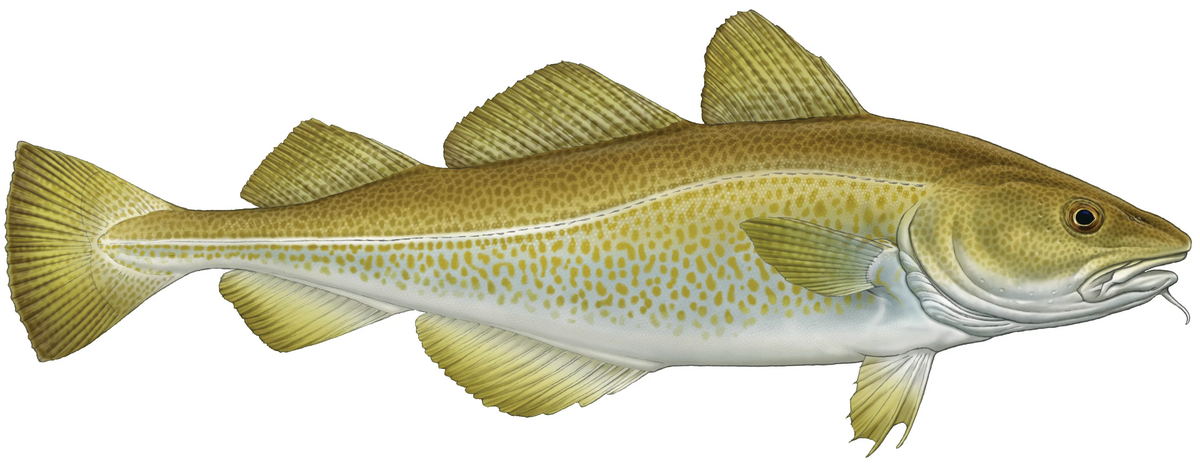Cod
Cod - Image courtesy of Seafish Public Media
Atlantic Cod - Scientific name - Gadus morhua
Conservation status
Cod are all wild-caught. They have a chequered conservation record with half of the fishing grounds falling into the Avoid category of the MCS. Cod are commonly fished using bottom trawl. They are classed as Least Concern on the IUCN Red List (2013).
The MCS report that most Cod sold in the UK is from Iceland or the Arctic, which is generally OK but Needs Improvement according to their ratings.
Cod are listed on the Greenpeace Red List with the exception off the North East Arctic which is ‘relatively healthy’. Most stocks in the North Atlantic are in ‘poor condition’.
They say:
‘Atlantic Cod stocks have suffered heavily from overfishing on both sides of the Atlantic. In the major fishing areas for cod in US and Canadian waters of the Northwest Atlantic, stocks have and continue to be overfished. A further concern is that cod are often caught using bottom trawling gear which damages seabed habitats that are important for the survival of many other species and catches and kills unwanted species.’
Overview
Cod is a medium sized fish typically weighing between 5 and 12 kilos (though cod have been recorded as heavy as 100 kilos). They have a distinct white line that runs the length of their body from their gill to their rear fin. They are typically coloured greenish to sandy brown on their back often mottled and they have a white belly.
It’s difficult to pinpoint when cod originated but they have been recorded back to the Vikings around 800AD.
Cod are gregarious and form schools. They live in varied habitats, favouring rough ground, especially inshore as well as living near the sea bed in depths between 6 and 60 metres.
They live to a maximum of 25 years.
Cod are found around the UK. Major spawning grounds are in the middle to the south of the North Sea, the start of the Bristol Channel (north of Newquay), the Irish Channel (both east and west of the Isle of Man), around Stornoway, and east of Helmsdale.
Cod are commonly fished using bottom trawl, hook and line, and gill nets.
According to the MCS –
Bottom trawlers targeting cod and haddock in the northeast Arctic must use at least 130mm mesh size and have a sorting grid in the net, which help small fish and other species to escape. Some areas are closed to fishing to protect juveniles, and vessels that catch too many juveniles must move 5nm away from the location. Discarding of unwanted or below-minimum-size fish is considered to be negligible in recent years.
Vessel monitoring systems are required on all Norwegian vessels, regardless of size, allowing real-time tracking of fishing locations and compliance with closed areas. Catches are reported electronically, which helps to monitor compliance with catch limits. The Russian fleet has 100% scientific observer coverage, which ensures catch data is accurate.
Increased surveillance and monitoring at sea and in the air by Russian and Norwegian authorities, including greater participation by regulation-compliant fishing vessels, and greater cooperation from receiving port authorities, is reported to have practically eradicated Illegal, Unreported and Unregulated fishing in the Barents Sea.
Cod are often viewed as indiscriminate feeders, scavenging on the sea bed or mid waters eating almost anything they find. They will eat fish such as herring and sand eel, crustaceans, and invertebrates like marine worms and shellfish.
Cod is popular with humans, particularly in the UK, as well as various marine animals, including spiny dogfish, sharks, and marine mammals all enjoying cod.
Atlantic cod is a common ingredient in fish and chips (as well as Haddock), popular for its mild flavour and flaky texture. Cod livers are processed to make cod liver oil an important source of vitamin A,D,and E with omega-3 fatty acids.
Fishing History and Hull
Cod has a long fishing history with William Pitt the Elder claiming Cod as ‘British Gold’ in the 18th century. Many of the fishing grounds are far away from the UK.
In 1992 the Canadian fishing minister declared a 2 year moratorium on the Northern Cod fishery, an area off the coast of Newfoundland as the total cod biomass had collapsed to less than 1% of its normal value.
Iceland was part of the Cod Wars in the mid to late 20th century – a series of disputes between the UK and Iceland. The fishing of Cod and other fish has become an important political issue and led to the restriction of catches to allow stocks to restore.
Cod has particular resonance with Hull and its fishing history. There is evidence of fishing back to the 12th century, but it was in the mid 19th century that Hull’s fishing thrived due in particular to its proximity to the rich Dogger Bank fishing grounds. Hull's distant-water trawling fleet played a vital role in supplying fish to the nation, with cod being a key species. Cod trawlers were caught up in the Cod Wars: there is an interesting film Cod and Communism that gives dramatic coverage of gunboats ramming trawlers and documents the history and politics of the time. (on DVD from the Carnegie Heritage Centre web site (www.carnegiehull.co.uk)). See also Jo Byrne’s essay ‘Following the Fish’ in this project.
Sources
Wikipedia - https://en.wikipedia.org/wiki/Cod
Marine Conservation Society - https://www.mcsuk.org/goodfishguide/species/atlantic-cod/?search=cod
IUCN - https://www.iucnredlist.org/species/8784/12931575
The Hull Story - https://www.thehullstory.com/
Greenpeace - http://www.greenpeace-fishforlife.50webs.com/redlists.html
